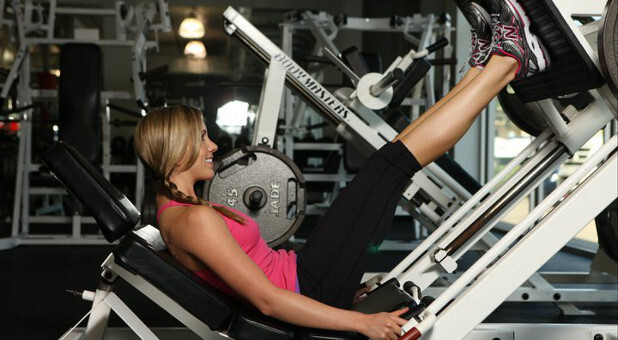“Beloved, do not be surprised at the fiery ordeal that is taking place among you to test you, as though some strange thing happened to you” (1 Peter 4:12, MEV).
How does the verse above relate to today’s topic of muscle soreness? I think if you would replace the word “ordeal” with “muscles,” you might get a better idea …
Of course, the above parallel is simply a jest and by no means an exegetical attempt at making Peter out to be a first century personal trainer. However, you’d be surprised by how many exercise newbies find sore, “fiery” muscles rather surprising, and many times, also discouraging.
As part of a six-week women’s challenge at our gym, another coach and I have been assigning our team members specific “homework” to help them reach their goals by the end of the challenge. Some of the ladies want to shed eight to 10 pounds. Others want to be able to do a pull-up without assistance, and still others want to set a new P.R. (personal record) on their squat and deadlift.
What they all have in common—as evidenced by the texts I’ve received a day or two after their homework is completed—is good ol’ muscle soreness. In this article, I want to discuss muscle soreness—what it is and isn’t, when it’s beneficial and when it’s not, as well as how to alleviate it.
Whether it’s sore quads and hamstrings after extra running, or tender traps from perfecting power cleans, the ladies’ muscles are actually making adaptations to better prepare themselves for performing the pain-inducing activity again (pretty smart, right?). Microfractures in the muscle cells and surrounding connective tissues has caused a bit of inflammation. Swelling may occur as well (note that any engorged biceps and deltoids are swollen—not magically bigger after one workout!) as a response to microscopic muscle tears.
None of that sounds very pleasant, and to be honest, it isn’t. However, as is true with many of life’s blessings, rewards are not often reaped without a healthy dose of … vexation, shall we say? What the writer of Hebrews says is true:
“No discipline seems to be joyful at the time—but grievous. Yet afterward it yields the peaceful fruit of righteousness in those who have been trained by it: (Hebrews 12:11, MEV).
Sore muscles now = stronger, healthier, more powerful, and better prepared muscles later. And as a bonus, the workouts that produce them nurture habits of discipline and perseverance that translate seamlessly into other aspects of our lives outside the gym.
So is there a bright side to sore muscles? Can they be avoided? Well, the answer turns out to be yes. Or rather, sort of…
Generally those who experience the “post-workout waddles,” as I shall call them, are those who haven’t exercised in ages. Their muscles simply aren’t accustomed to the work they’re being asked to do. But if they stick it out and continue training consistently, they will start to feel less sore as their bodies adapt to their workouts and learn to distribute the workload across their muscle fibers more effectively.
I should add here that while a lack of muscle soreness is nice, it could also be a sign that your body has stopped growing and adapting to training stimuli, meaning your fitness has reached a plateau. Therefore, it’s important to regularly change up your exercise routine by trying new exercises, changing your rep scheme, using heavier weights, etc.
Delayed onset muscle soreness (DOMS) generally disappears after three days, but this varies from person to person. Three days is a long time to endure washing your hair with inflamed triceps or turning the steering wheel with aching pecs. Thankfully, there are proven ways to lessen the dreaded DOMS and go about your life without blowing your budget on Ibuprofen:
Warm up and cool down well: The American College of Sports Medicine suggests advancing slowly with a new workout, giving your muscles time to adapt and recover. A post-workout cool down, comprised of foam rolling, stretching, and other mobility drills, will reset your body to a natural position and posture, which will diminish stiffness and soreness. Here’s an in-depth article on the importance of warming up and cooling down and how to do them effectively.
Take a warm shower or find a hot tub: Warm water is a natural relaxer. If you’re bruised for any reason, or exceptionally inflamed, apply an ice pack to the affected area for up to twenty minutes, two to three times a day, if possible.
Take Epsom salt baths: Epsom salts are composed of magnesium sulfate. Magnesium is natural muscle relaxant, and as a salt they help to pull excess fluids out of the tissues, reducing swelling.
Increase your protein intake: This will increase protein synthesis, helping rebuild muscles.
Get a massage: Massages help stimulate blood circulation to an area, which speeds healing.
Get your sleep: Your body repairs, rebuilds, and recovers while it’s resting.
Try a saffron or ginger supplement: New research in the Clinical Journal of Sports Medicine suggests that supplementing with saffron may also help to alleviate DOMS. Additionally two studies done at Georgia College and State University in 2010 looked at how ginger affected muscle pain and inflammation after exercise.
One experiment had subjects supplement with two grams of ginger for several days and perform curls in the gym. The next day, their soreness was significantly less than expected. The other study also examined the effects of two grams of ginger on arm training. Participants consumed ginger 24 hours and 48 hours after exercise, and the pain was reduced 13 percent by the second day.
If you’re still feeling intensely sore after the 72 to 96-hour mark, you experience abnormal swelling in your limbs or see that your urine is dark, you should see your doctor. If the pain is due to an injury, you most likely felt it immediately, while in the middle of your workout. Soreness, on the other hand, is gradual.
Also remember to give specific muscle groups at least 48 hours before training them again. For example, if you trained your back and biceps on Monday, train them again no sooner than Wednesday or Thursday.
I hope you’ve found this article helpful, and that you won’t “be surprised at the fiery ordeal” that is your angry muscles, as my husband not-so-affectionately refers to them. Train hard, have fun, and keep your health all about God and honoring Him with the body He’s given you!
Stay fit, stay faithful.
Diana Anderson-Tyler is the author of Creation House’s Fit for Faith: A Christian Woman’s Guide to Total Fitness, Perfect Fit: Weekly Wisdom and Workouts for Women of Faith and Fitness, and her latest book, Immeasurable: Diving into the Depths of God’s Love. Her popular website can be found at dianaandersontyler.com, and she is the owner and a coach at CrossFit 925. Diana can be reached on Twitter.
For the original article, visit dianandersontyler.com.











































